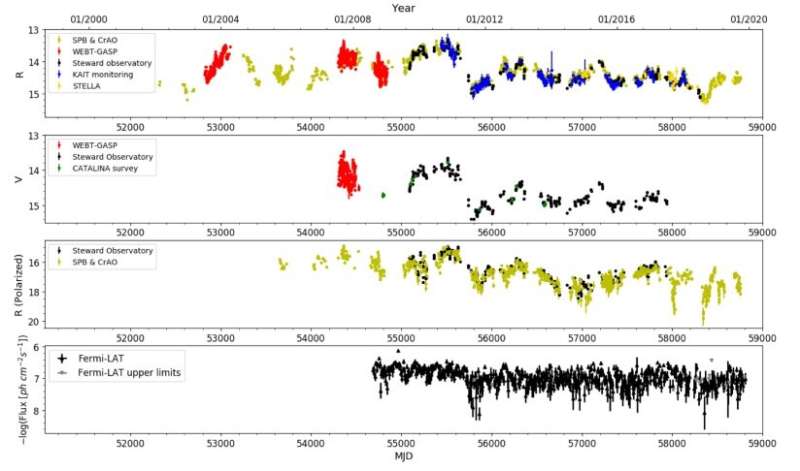Long-term light curves of 3C 66A. From top to bottom: Optical R band, Optical V band, Polarized magnitude in the optical R band and Fermi-LAT γ-ray light curves. Different colors and symbols denote data from the different observatories used in the analysis. Credit: Santos et al., 2020.
An international team of astronomers reports the detection of quasi-periodic variability in optical and gamma-ray light curves of two blazars, namely 3C 66A and B2 1633+38. The discovery could be helpful in advancing our knowledge about such behavior in blazars. The finding is detailed in a paper published January 16 on arXiv.org.
Blazars are very compact quasars associated with supermassive black holes at the centers of active, giant elliptical galaxies. They belong to a larger group of active galaxies that host active galactic nuclei (AGN), and their characteristic features are relativistic jets pointed almost exactly toward the Earth. Based on their optical emission properties, astronomers divide blazars into two classes: flat-spectrum radio quasars (FSRQs) that feature prominent and broad optical emission lines, and BL Lacertae objects (BL Lacs), which do not.
Blazars can exhibit variability on a wide range of timescales, from minutes to even years. Detection and studies of various periodicity patterns could be essential for better understanding of blazar emission models. In particular, periodicity studies have the potential of shedding more light on the processes taking place in the jets and accretion disks of black holes in active galaxies.
A group of astronomers led by Jorge Otero Santos of the University of La Laguna, Spain, has now found two more blazars that appear to showcase a quasi-periodic behavior. Using a set of various telescopes, they found evidence of possible quasi-periodic variability in the optical photometric data of blazars designated 3C 66A and B2 1633+38.
"We report on quasi-periodic variability found in two blazars included in the Steward Observatory Blazar Monitoring data sample: the BL Lac object 3C 66A and the Flat Spectrum Radio Quasar B2 1633+38," the astronomers wrote in the paper.
The study found evidence of quasi-periodic variability in the optical light curves of 3C 66A with a period of about three years, and a possible secondary period of around 2.3 years in the R band. In addition, a period of approximately 180 days was detected and no periodic behavior has been observed in either the polarized or gamma-ray light curves.
When it comes to B2 1633+38, the research found evidence of quasi-periodicity in both the optical total and polarized flux light curves, with a period of about 1.9 years. A hint of periodicity was also detected in the gamma-ray light curve of this blazar. However, the astronomers were not able to confirm that the recurrence of these gamma-ray flares is periodic as the emission is dominated by flares only during a part of the gamma-ray light curve, combined with a long quiescent state.
The researchers ponder possible scenarios that could explain the observed quasi-periodic behavior in the two blazars. "We propose different jet emission models that could explain the quasi-periodic variability and the differences found between these two sources," the astronomers noted.
The authors of the paper wrote that the existence of a supermassive binary black hole (SBBH) could explain such behavior, as the presence of a second perturbing black hole could either modulate the accretion rate or produce a precession in the blazar's jet. They propose this hypothesis as the most plausible for 3C 66A.
Other scenario taken into account is that the variability could be due to geometrical effects such as helical jets or helical structures in the jet. This explanation is favored for B2 1633+38, however, the astronomers do not exclude the possibility that it could be also applied to 3C 66A.
More information: Quasi-periodic behaviour in the optical and γ-ray light curves of blazars 3C 66A and B2 1633+38, arXiv:2001.06014 [astro-ph.HE] arxiv.org/abs/2001.06014
© 2020 Science X Network
























